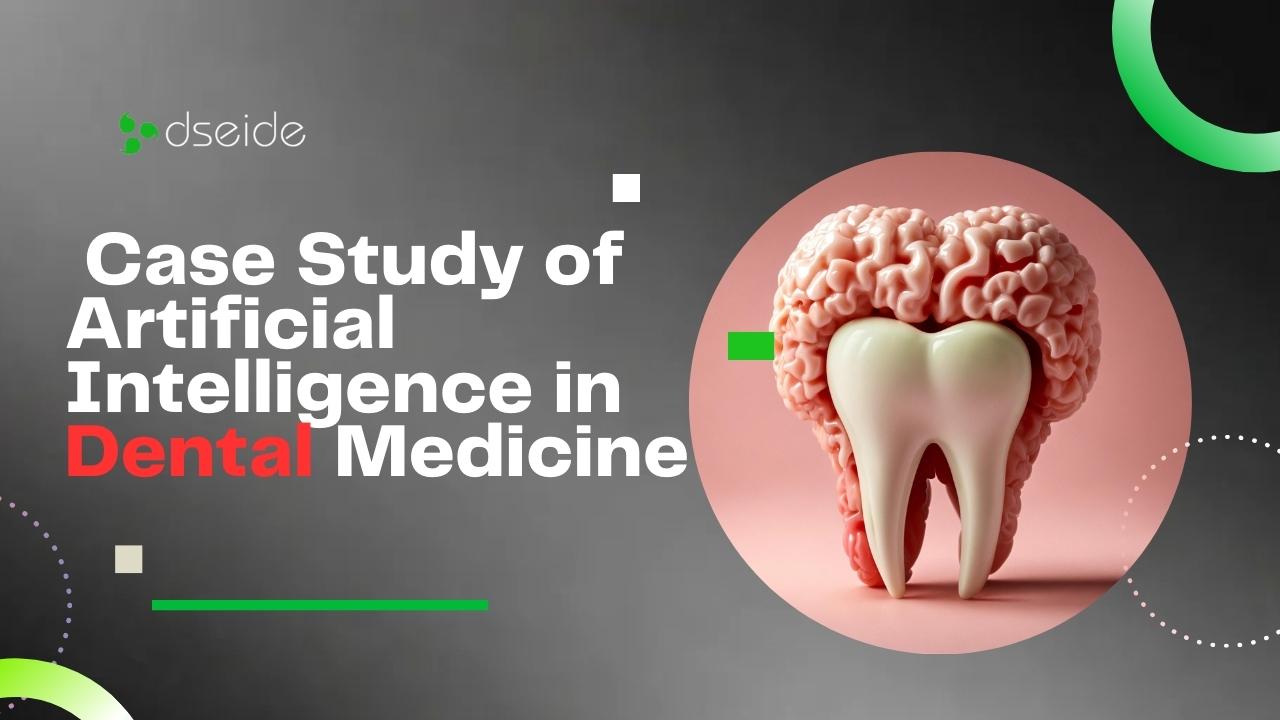Revolutionizing Dental Care: A Fictitious Case Study of Artificial Intelligence in Dental Medicine

Revolutionizing Dental Care: A Fictitious Case Study of Artificial Intelligence in Dental Medicine
Introduction: The Dawn of AI in Dental Medicine
Artificial intelligence (AI) is making waves across various sectors, and dental medicine is no exception. While AI has already been embraced in many areas of healthcare, its adoption in dentistry is relatively new. This case study illustrates the transformative potential of AI in dental medicine, focusing on how AI could enhance both administrative efficiency and clinical practice.
In this fictional scenario, we follow Joe, a patient with dental anxiety, through his journey with AI-integrated dental care, highlighting the revolutionary applications of AI in every stage of his dental treatment.
Joe’s Dilemma: Facing the Dentist
Joe, like many people, has always dreaded visiting the dentist. The very thought of the clinical smell, the high-pitched whirring of dental drills, and the vulnerability of lying back in a dental chair makes him anxious. However, after experiencing a severe, throbbing pain in his lower left molar, Joe realizes he can no longer avoid a dental visit.
Desperate for a solution, he turns to MolarMate, a cutting-edge dental AI assistant he found online. MolarMate has been designed to assist patients by providing preliminary assessments, scheduling appointments, and even offering anxiety management techniques—all through a user-friendly digital platform.
The First Interaction with the AI Assistant
With a mixture of curiosity and skepticism, Joe opens the MolarMate app and describes his symptoms:
Joe: “I have throbbing pain on the lower left part of my mouth. It’s keeping me up at night. What could this be, and what should I do?”
MolarMate: “Throbbing pain in the lower left part of the mouth can be a sign of several dental issues. The most common causes include:
- Tooth decay or cavity: Pain localized to a specific tooth could indicate decay or a cavity, which may worsen with hot, cold, or sweet foods.
- Tooth abscess: A serious infection occurring when bacteria enter the tooth pulp.
- Gum disease: Conditions like gingivitis or periodontitis can cause sensitivity and pain.
- Impacted wisdom tooth: Pain at the back of the mouth might indicate an impacted wisdom tooth.
- Temporomandibular joint disorder (TMJ): Issues with the jaw joint can cause radiating pain in the lower jaw.
To address the issue, consider consulting a dentist. What is your availability for the coming week? I’ll schedule an appointment with a dentist in your network.”
AI Takes Charge: Scheduling the Appointment
MolarMate quickly identifies Joe's location, dental insurance details, and calendar availability to schedule an emergency appointment with Dr. Grin, a local dentist within Joe’s network. MolarMate not only books the appointment but also ensures that all of Joe's medical and dental histories, as well as any relevant allergies, are summarized and sent directly to Dr. Grin’s office.
Preparing for the Dental Appointment: Alleviating Anxiety with AI
Joe, feeling nervous about his upcoming dental visit, turns again to MolarMate for support:
Joe: “I have extreme dental anxiety. Please help me find ways to relax before the visit. What should I expect?”
MolarMate: “Dental anxiety is common, but several strategies can help manage it effectively:
- Deep breathing exercises: Practice slow, deep breaths to calm your nerves.
- Progressive muscle relaxation: Tense and relax different muscle groups to reduce tension.
- Distractions: Bring headphones to listen to soothing music or an engaging audiobook.
- Sedation options: Ask your dentist about nitrous oxide, oral sedatives, or IV sedation.
- Pre-appointment tips: Avoid caffeine, and consider bringing a companion for emotional support.”
By providing these actionable tips, MolarMate helps Joe feel more in control and prepared for his dental visit.
The Day of the Appointment: AI-Enhanced Diagnostics and Patient Care
On the day of the appointment, Joe arrives at Dr. Grin’s office, where his experience is anything but ordinary. Thanks to MolarMate, all his insurance and background information is already in the clinic’s system, reducing the usual administrative hassle. Joe undergoes a full-mouth radiographic series, which is instantly analyzed by AI-driven computer vision software for signs of decay and bone loss. The AI pre-labels areas of concern on the radiographs, allowing Dr. Grin to focus on examining the specific points flagged by the AI.
Dr. Grin’s Diagnosis: An AI-Assisted Approach
After reviewing the AI-analyzed radiographs, Dr. Grin diagnoses Joe with irreversible symptomatic pulpitis—a condition where the pulp of the tooth becomes inflamed and infected, causing severe pain. The AI dental software, integrated with Dr. Grin’s system, compiles a list of potential treatment options for Joe, using multimodal diagnostic data such as his medical history, radiographs, and symptoms.
MolarMate sends Joe an interactive guide detailing each treatment option, including the pros, cons, costs, and expected outcomes. Joe is able to explore the different options, view image explanations, and ask specific questions about each procedure directly through MolarMate.
Selecting the Treatment Plan: AI-Driven Decision Making
Joe decides to proceed with a root canal treatment on tooth no. 19, followed by a crown placement. The AI software provides Dr. Grin with a rough estimate of the number of roots and their working lengths for the affected tooth.
During the procedure, MolarMate assists Joe with real-time anxiety management tools, such as guided breathing exercises and calming visualizations. The AI’s involvement does not end with diagnosis and treatment planning; it continues throughout the procedure, ensuring that Joe remains comfortable and informed.
Post-Procedure Follow-Up: AI-Facilitated Recovery
The root canal procedure is successful, and Dr. Grin instructs MolarMate to send Joe detailed post-op instructions, including medications, dosages, and safety precautions. The AI’s ability to automate post-operative care not only saves valuable time for Dr. Grin but also enhances patient compliance by delivering personalized and easily accessible information.
Joe can chat with MolarMate to get answers to any post-treatment questions, ensuring he feels supported throughout his recovery. The AI assistant also schedules his next follow-up appointment and helps plan his routine cleanings, keeping Joe on track for continued oral health.
Crown Preparation and Delivery: A Seamless Digital Experience
A few weeks later, Joe returns for his crown placement. Using a 3D scanner, Dr. Grin takes a digital impression of Joe’s tooth. The AI software uses data from previous scans and associated success or failure rates to recommend specific adjustments:
AI Recommendation: “Recommend occlusal reduction of 0.5 mm more on the mesiolingual cusp and address the distal undercut.”
By following these AI-driven suggestions, Dr. Grin ensures the crown will fit perfectly, improving both function and longevity. Joe is then asked to take a short break while the crown is fabricated in-house using CAD/CAM technology.
Same-Day Crown Fabrication: Speed and Precision with AI
Thanks to advanced 3D printing and milling technologies, Joe’s custom crown is ready within a few hours. When Joe returns, Dr. Grin checks the fit, margins, occlusion, and contacts, and confirms these with radiographs. With everything in order, the crown is cemented into place, restoring Joe’s tooth to full function.
Enhancing Patient Satisfaction: AI’s Role in Ongoing Care
Before Joe leaves, Dr. Grin updates MolarMate with details of the procedure. MolarMate immediately sends Joe tailored post-op instructions and follow-up care recommendations based on his specific medical history and treatment details. The AI assistant also helps Joe schedule future appointments, ensuring he stays on top of his dental care routine.
Joe leaves the clinic feeling relieved, pain-free, and satisfied with his experience. The seamless integration of AI throughout his journey has not only improved his clinical outcomes but also transformed his perception of visiting the dentist.
The Broader Impact of AI in Dental Medicine: Opportunities and Challenges
While this fictitious case study showcases the potential of AI to revolutionize dental care, it also highlights several broader implications:
Administrative Efficiency: AI can automate repetitive administrative tasks, such as scheduling, billing, and patient record management, freeing up valuable time for dental staff to focus on patient care.
Enhanced Diagnostics: AI tools, like computer vision software, can analyze radiographs and other diagnostic images with remarkable accuracy, potentially identifying issues that might be missed by human eyes.
Personalized Patient Care: AI can leverage patient data to create personalized treatment plans and follow-up care, improving patient satisfaction and outcomes.
Patient Engagement and Education: Interactive AI platforms like MolarMate can educate patients on their conditions,treatment options, and recovery plans, leading to better compliance and engagement.
Overcoming Anxiety: AI can help reduce dental anxiety through personalized anxiety management tools, making dental visits less intimidating for patients.
However, the road to widespread adoption of AI in dental medicine is not without its challenges. High initial costs, concerns over data security, and the need for regulatory frameworks to ensure the safe and ethical use of AI in clinical settings are significant barriers that must be addressed.
Conclusion: The Future of AI in Dental Medicine
Artificial intelligence is set to revolutionize dental care by enhancing both administrative efficiency and clinical outcomes. From scheduling and diagnostics to personalized treatment plans and post-operative care, AI has the potential to transform every aspect of the dental experience. While challenges remain, the benefits of integrating AI into dental medicine are substantial, offering a glimpse into a future where dental care is more precise, efficient, and patient-centered.




